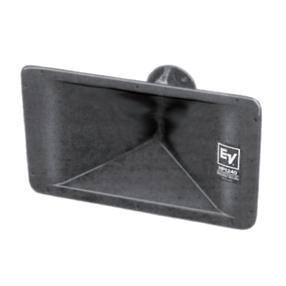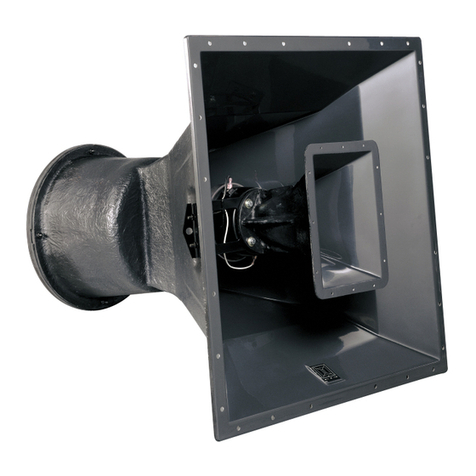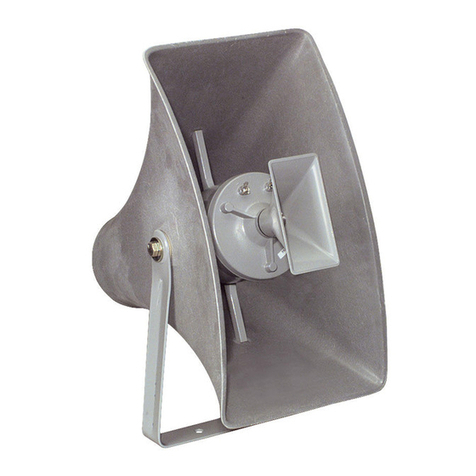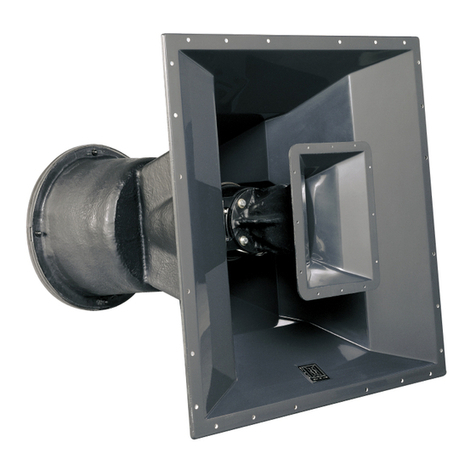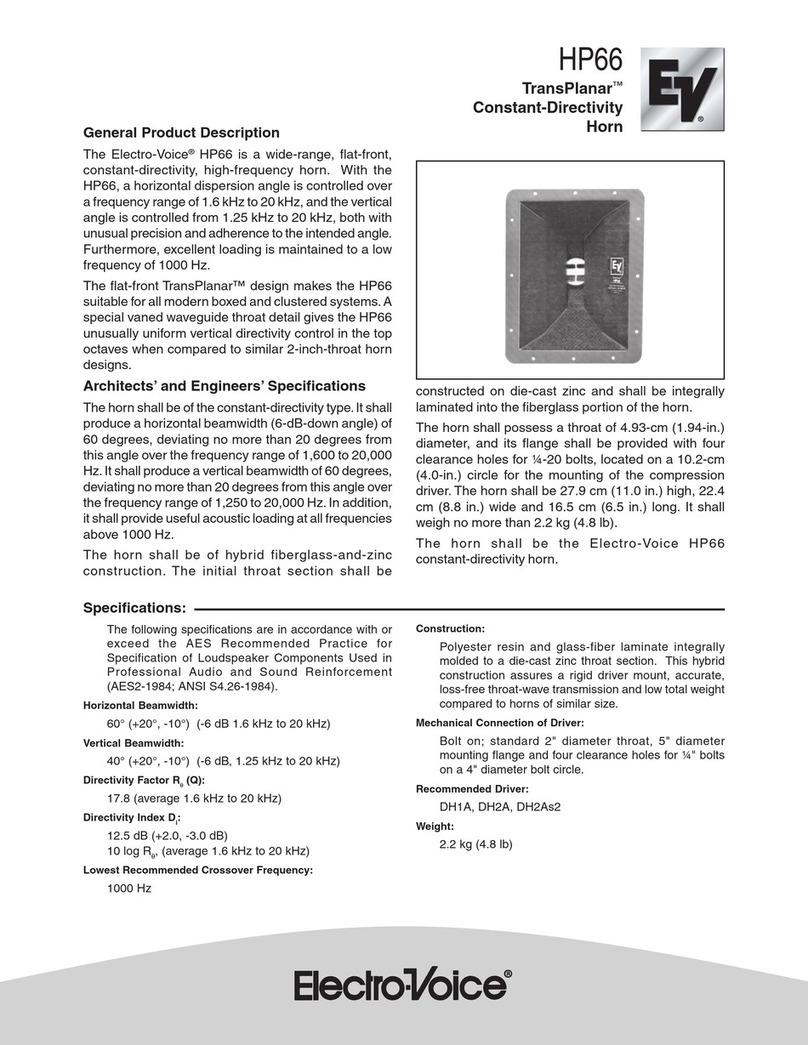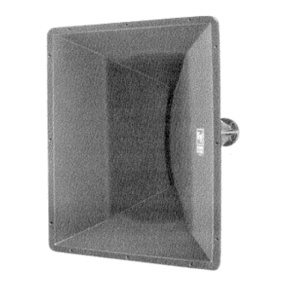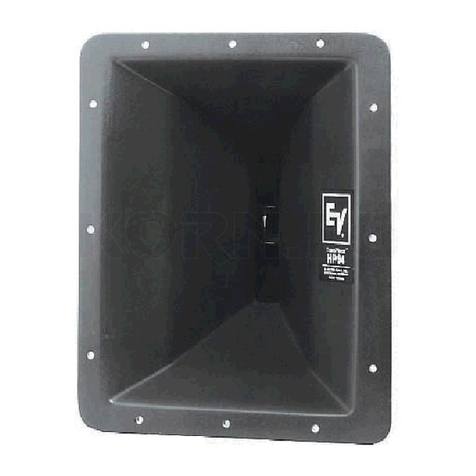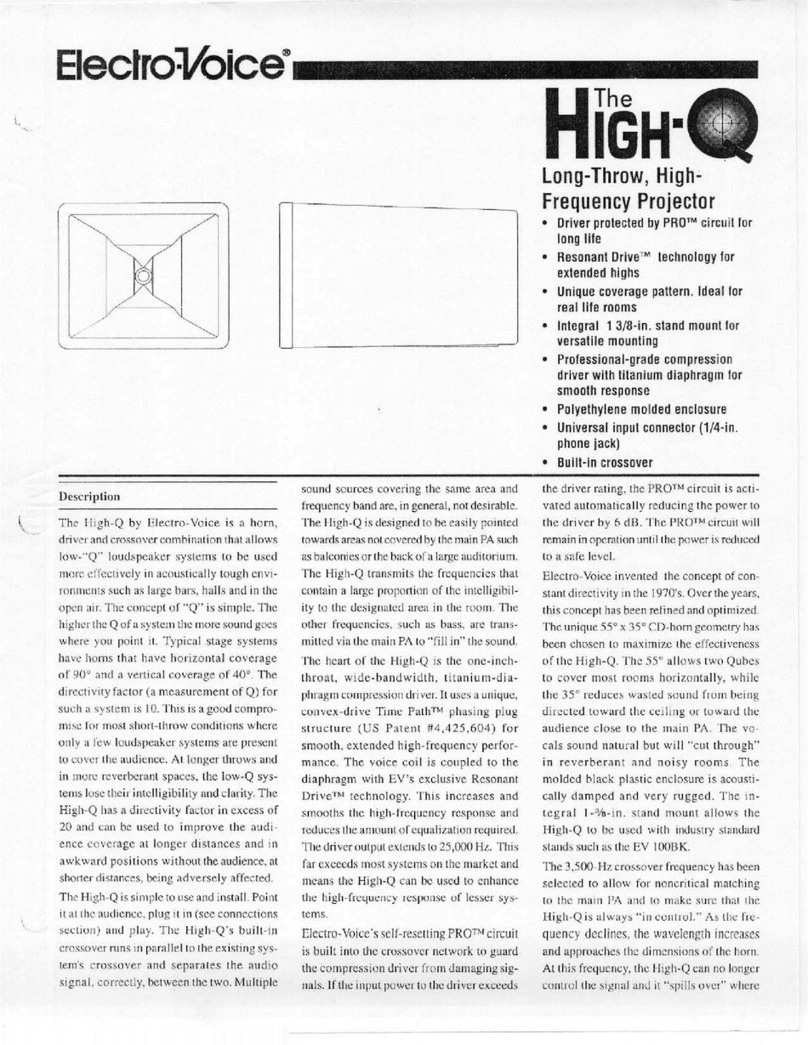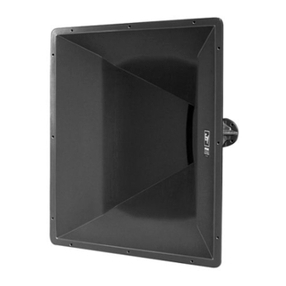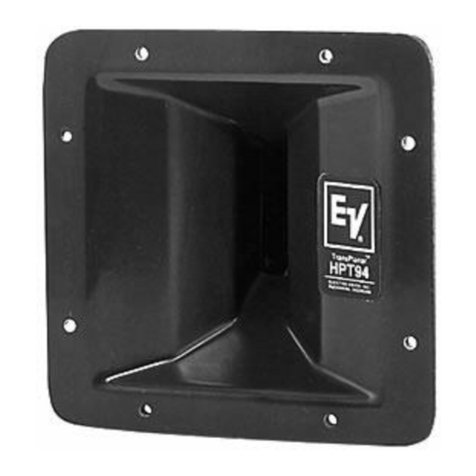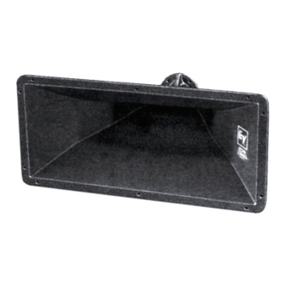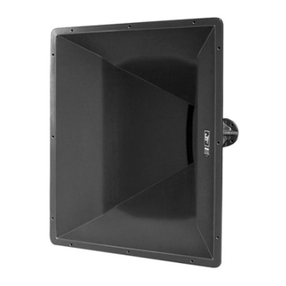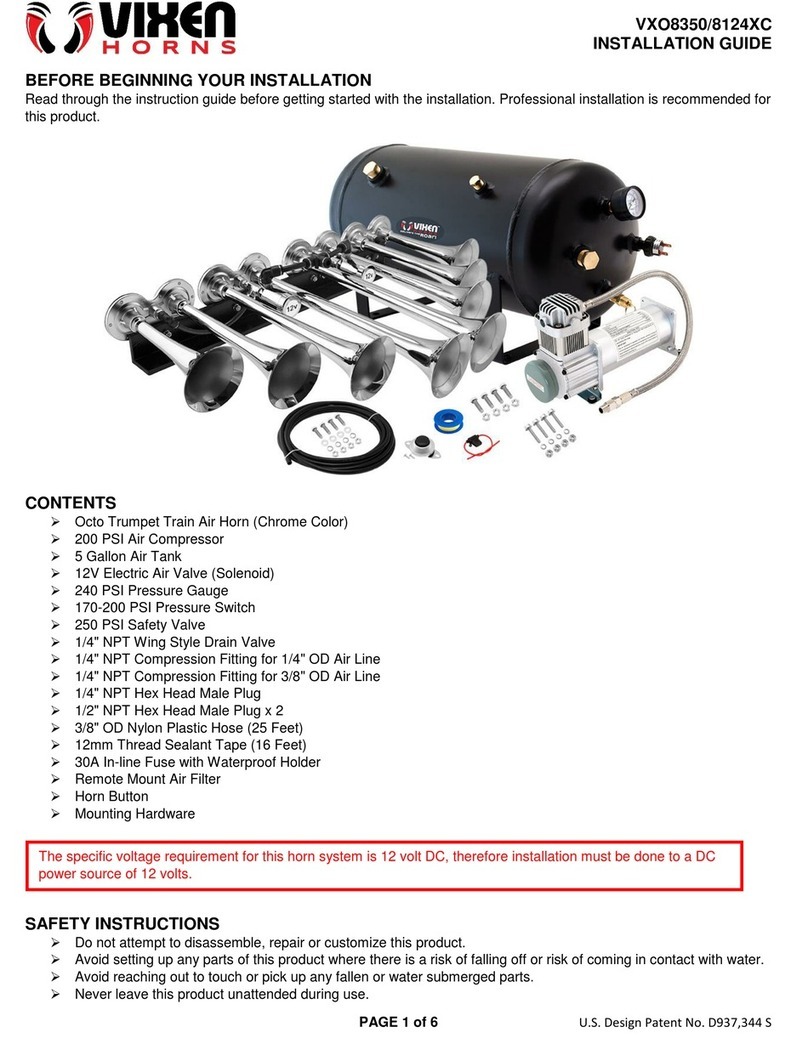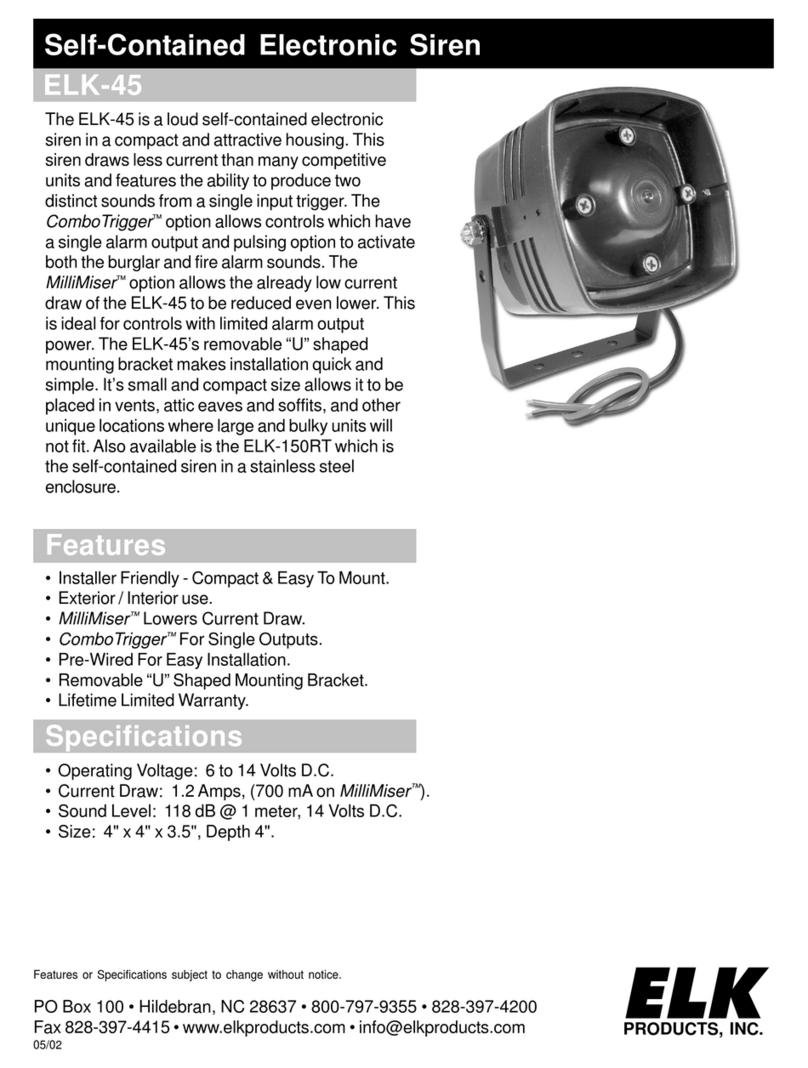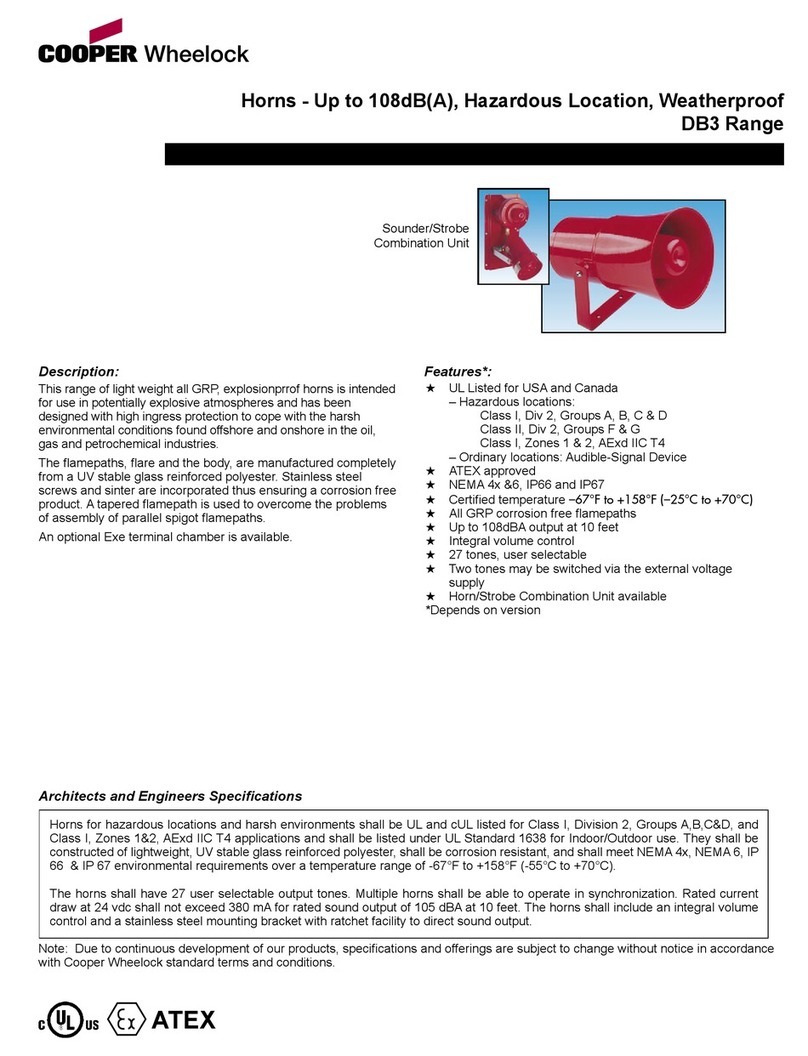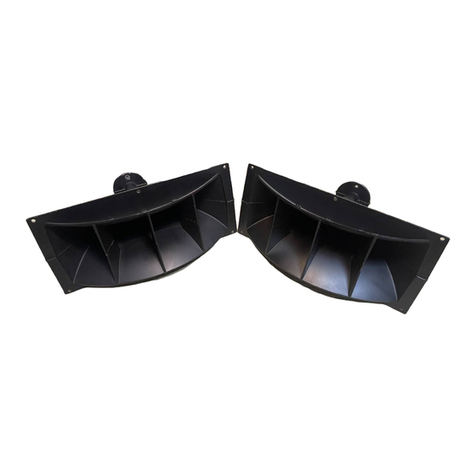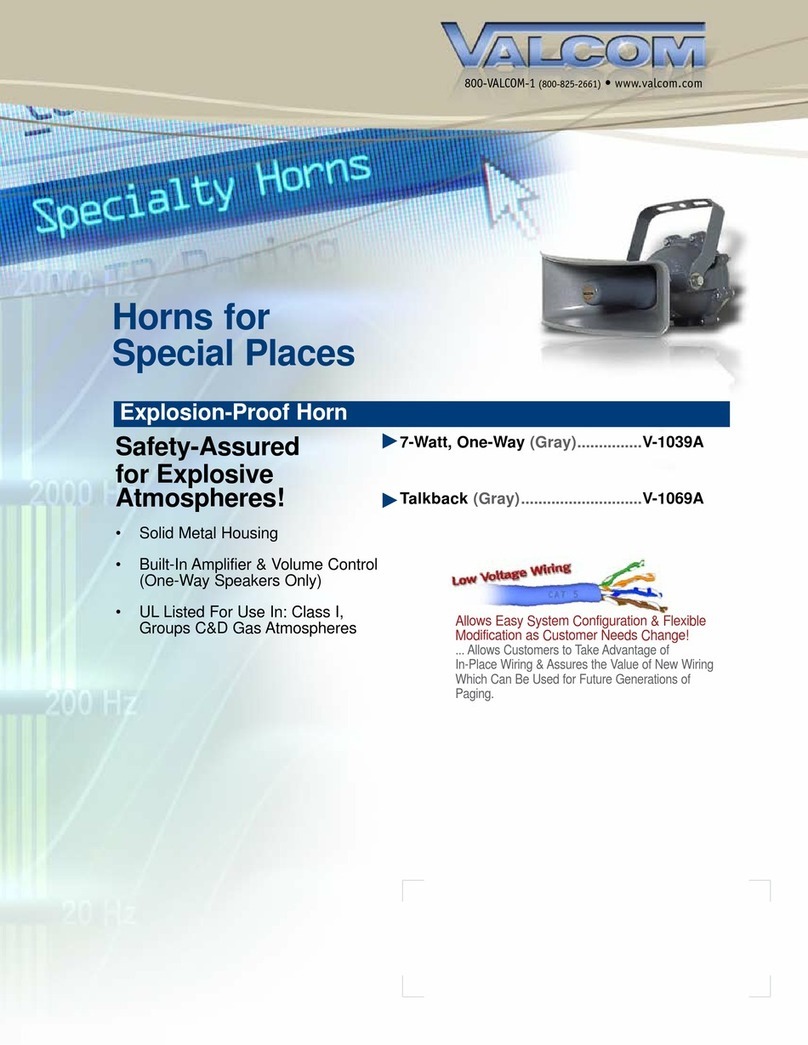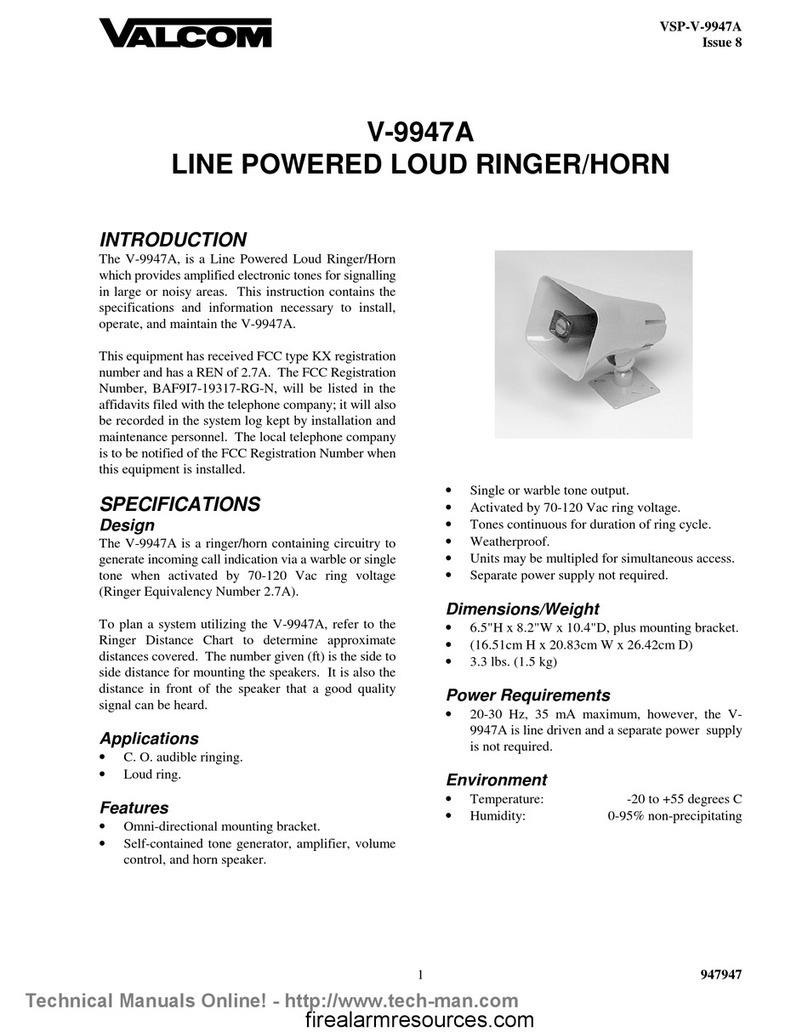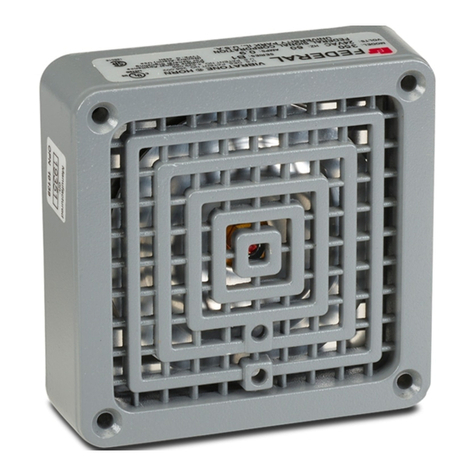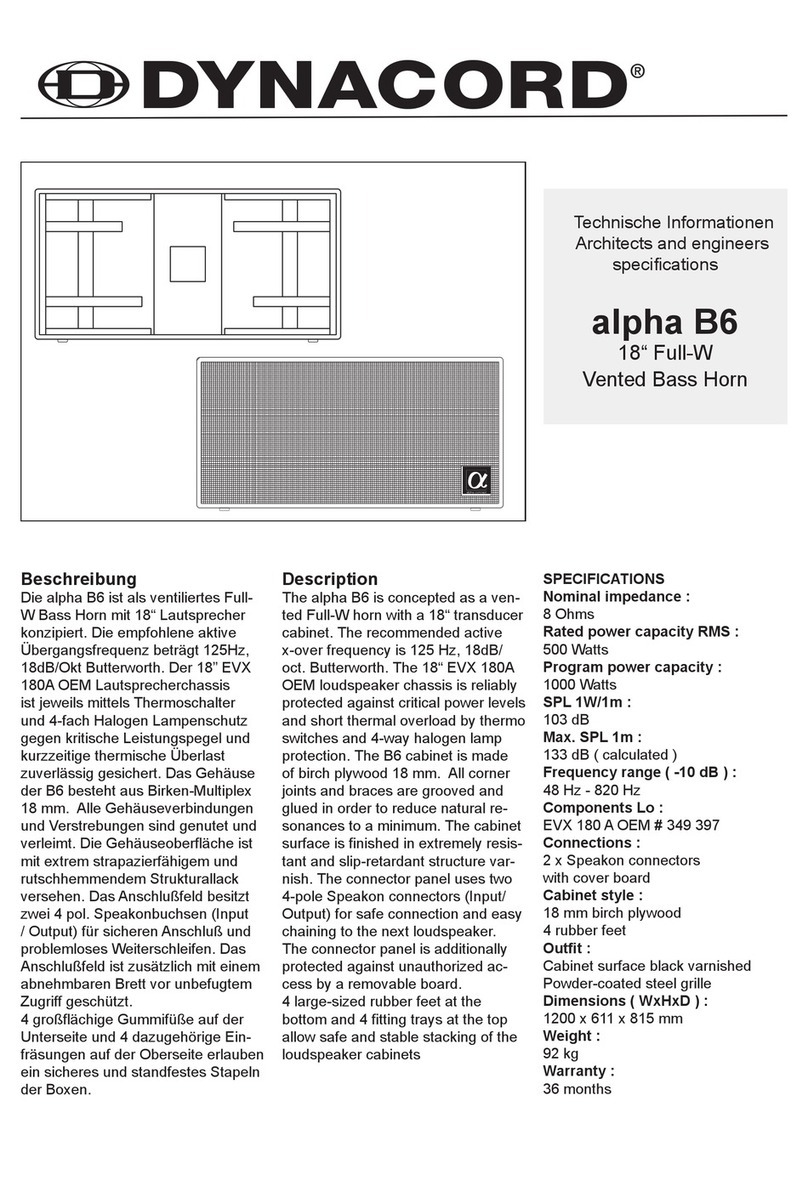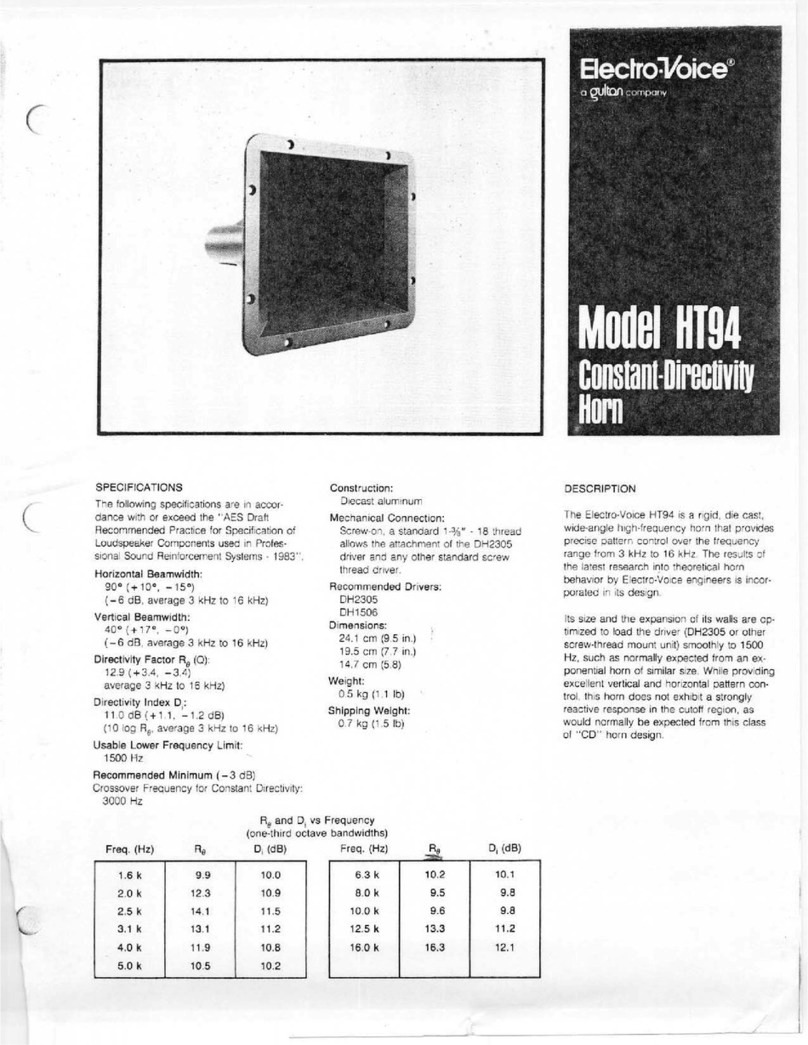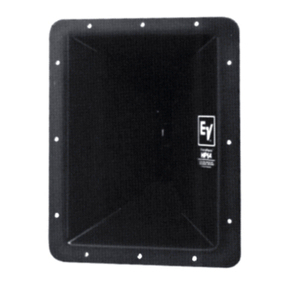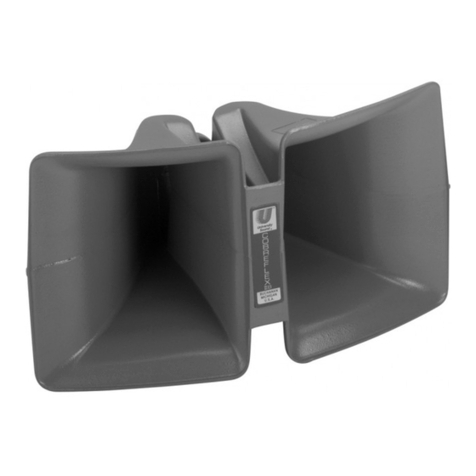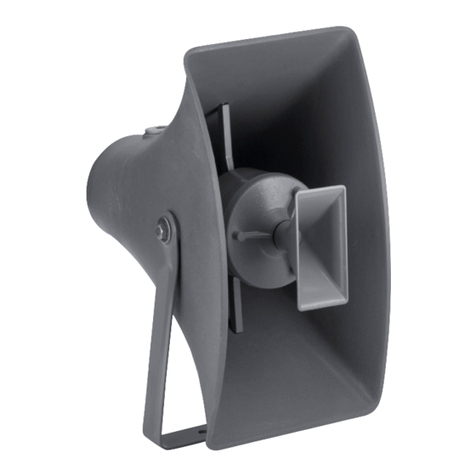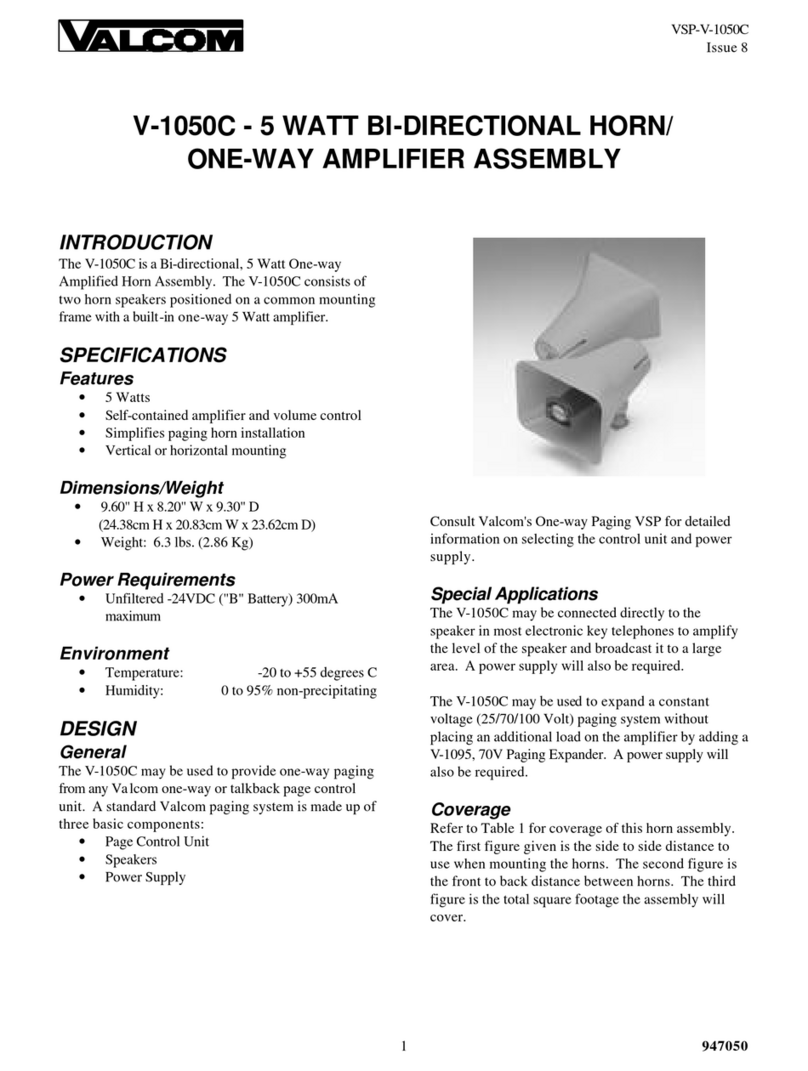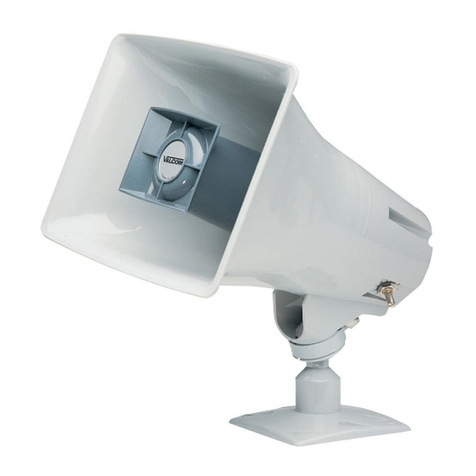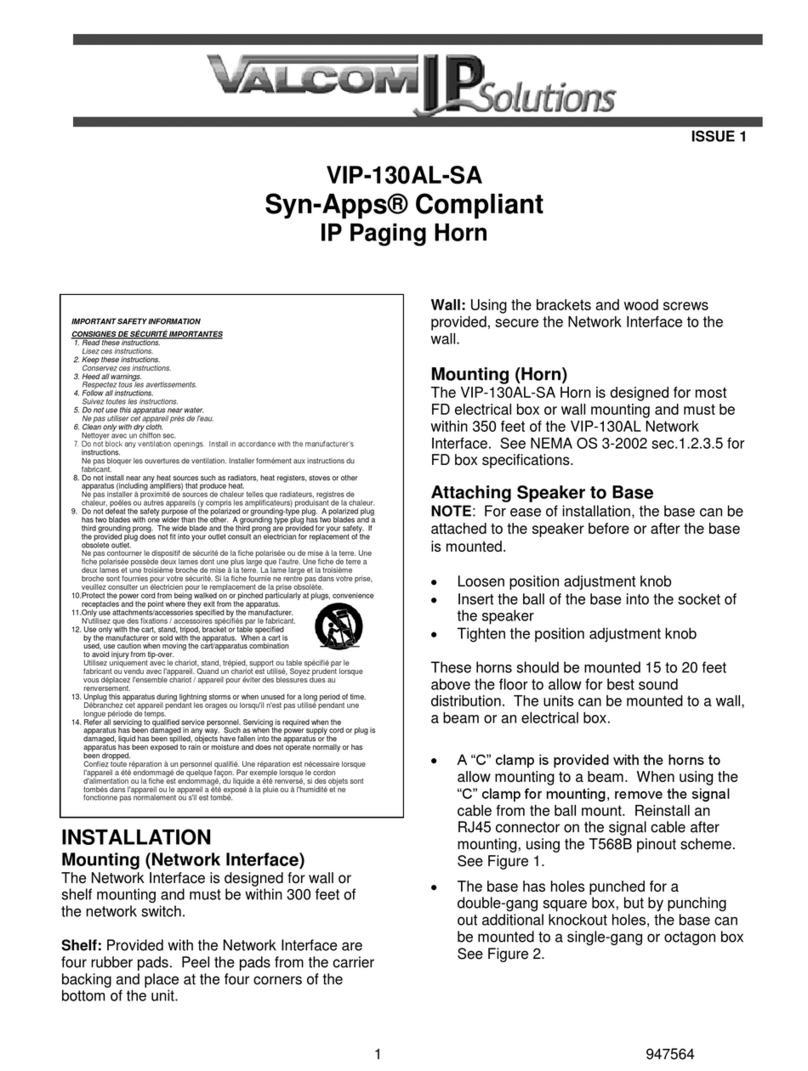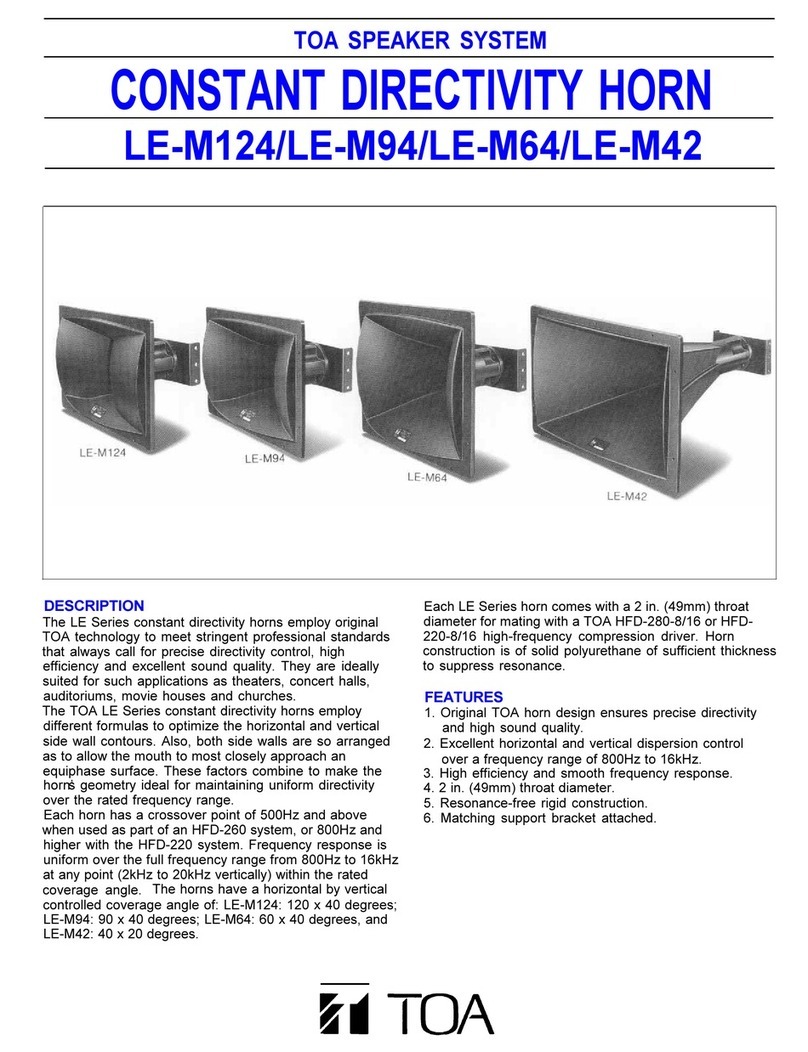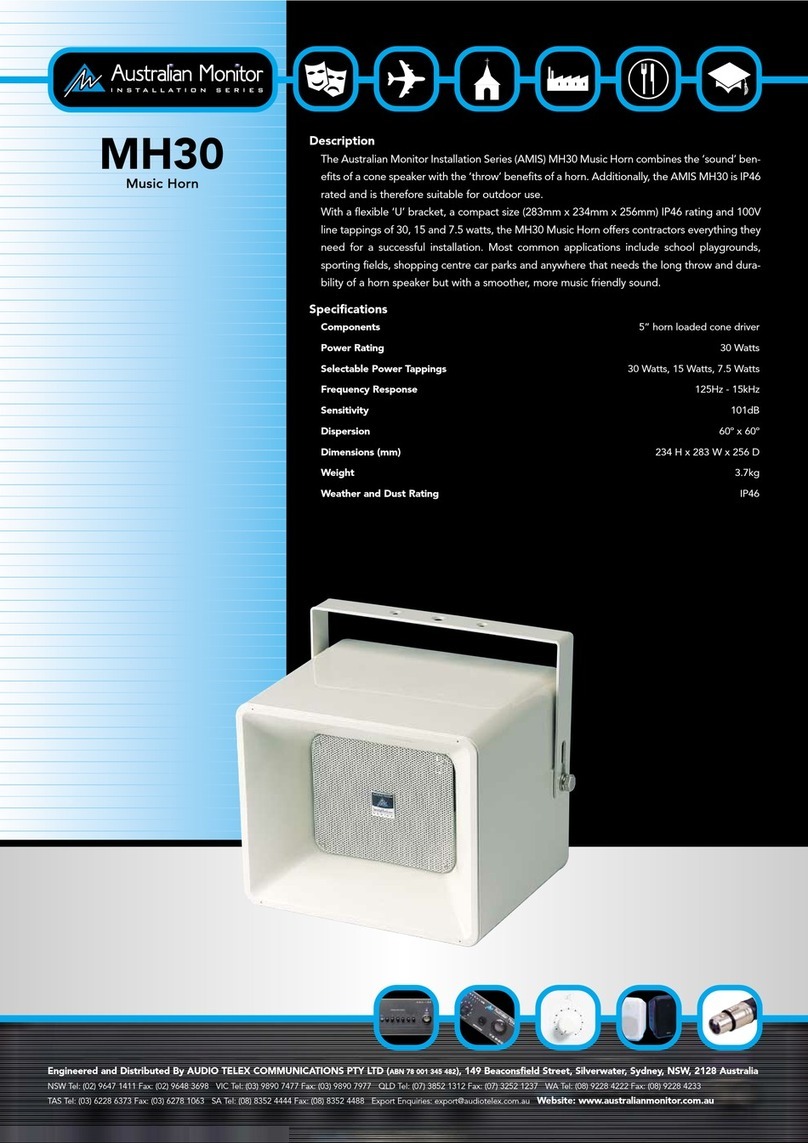The
MH660C
is a 60 x 60 deg. two-way system
with mid-bass and high-frequency horns that
are coaxially mounted. The common acoustic
axes of these horns ensures smooth response
and coverage in the crossover region when the
appropriate signal delay is applied to the
high-
frequency driver.
Delivering smooth and extended performance,
the high-frequency sectionoperatesfrom 1,600
to 20,000 Hz and consists of a specially
developed, low-profile
DH2As2
compression
driver coupled to an HP64 60 x 60
constant-
directivity horn. The HP66 horn features inte-
gral fiberglass-and-zinc construction for excep-
tional strength and performance.
Beamwidth-
control vanes in the horn throat correct all
coverage anomalies in the
10-
to
20-kHz
oc-
tave. This horn and driver combination is se-
curely mounted to the mid-bass horn by a
heavy-duty steel bracket.
The mid-bass system is composed of a
DL1
0X-SH 24.5-cm (10-in.) reproducer
mounted on a MH660 60 x 60 deg. mid-bass
horn. The
DL10X-SH
reproducer contains a
Kevlar epoxy
cone, which is twice as strong as
the conventional paper cone. The mid-bass
section operates between 140 and 1,600 Hz,
and features a proprietary phase plug (U.S.
patent no.
4,718,517)
which extends the
high-
end output to blend seamlessly into the coaxial
high-frequency section.
If the MH660Cis used in a full-range applica-
tion, additional low-frequency reinforcement,
such as the PI1 15L or a TL-series enclosure
will be required.
APPLICATIONS
The
MH660C
has been designed specifically
with the permanent installation market in mind.
Sports arenas, performing arts centers, audito-
riums and large gymnasiums are all candidates
for the
MH660C.
With its superior directivity
control, the
MH660C
is a system that can be
used in almost any situation. The
concert-
sound pedigree of the
MH660C
is evident by
the ease of installation and by the use of profes-
sional-grade components throughout the line.
SUSPENDING MH660C ENCLOSURES
Suspending any object is potentially danger-
ous and should only be attempted by individu-
als who have a thorough knowledge of the
techniques and regulations of rigging objects
overhead.
Electro-
Voice strongly recommends
that the
MH66OC
be suspended taking into
account a// current national, federal, state and
local regulations. It is the responsibility of the
installer to ensure the
MH660C
is safely in-
stalled in accordance with all such regulations.
If
the
MH660C
is suspended,
Electro-Voice
strong/y recommends that the system be in-
spected af
least
once a year.
If
any sign of
weakness or damage is detected, remedial
action should be taken immediate/y.
A manual entitled installing the MH Series is
available from Electro-Voice. It is included with
every MH system and should be followed care-
fully. A general overview is included here to
help the system designer. This overview does
not replacethe installing the
MHSeries manual,
which includes additional information on sus-
pending, configuring and equalizing the MH
series.
1.
Kevlar is
a
registered
trademark of
Dupont.
The
MH660C
can be suspended using the two
front brackets and the rear
“U”
bracket (see
Figure 5). Therear "U” bracket must be screwed
to the rear cover with the bolts provided. Each
of the mounting brackets contains a %-in.-
diameter hole through which a shackle or chain
link could pass. The MH660C can be oriented
in any direction. Electro-Voice strongly recom-
mends that each MH660C be suspended inde-
pendently using at least three of the four sus-
pension points provided.
If the
MH660C
is
suspended,it is recommended
that the unit be inspected at least once a year.
If any sign of weakness is detected, remedial
action should be taken immediately.
CAUTION: The
MH660C
speaker systems
should be suspended overhead
only In ac-
cordance with the procedures and
Iimita-
tfons specified in the installation manual
Included wlth the systems.
CONNECTIONS
Each frequency section can be individually
connected via#10 screw terminals. All drivers
are connected with the same polarity. A posi-
tive voltage applied to the positively marked
terminal produces a positive acoustic pressure
at the front of the system.
CROSSOVER, EQ AND SIGNAL DELAY
The
MH660C
is a two-way system which must
be biamped with a separate active crossover.
24-dB-per-octave crossover slopes are as-
sumed for maximum performance and reliabil-
ity. For optimum performance, EQ and signal
delay are required. (Note: the delays noted
below are for fourth-order
(24-dB-per-octave)
Linkwitz-Riley crossover filter characteristics.)
The mid-bass section should be crossed over
to match the low-frequency section and at
1,600 Hz at the high end. No signal delay or
overall broadband EQ is required. The
high-
frequency section requires a
1,600-Hz
cross-
over and the typical constant-directivity-horn
high-frequency boost EQ. A
0.6-msec
signal
delay provides the smoothest response in the
crossover region. A low-frequency blocking
capacitor with a
3-dB-down
point of 800 Hz is
included.
An Electro-Voice XEQ-3 electronic crossover/
equalizer/time delay unit with EQW plug-in
module provides all of the necessary signal
processing. The
XEQ-3
is a three-way elec-
tronic crossover with adjustable crossover fre-
quencies utilizing Linkwitz-Riley 24-dB-per-oc-
tave filters and signal delay equalization to
achieve zero lobbing error.
FREQUENCY RESPONSE
The
MH660C
axial frequency response was
measured in Electro-Voice’s large
anechoic
chamber at a distance of 3 meters (10 feet) with
a swept sine-wave input (see Figure 1). It has
been normalized for 1 watt/l meter into the
mid-
bass section. Minimal level adjustment and
equalization have been used.
DIRECTIVITY
The directional characteristics of theMH660C
were measured in Electro-Voice’s large
anechoic
chamber, with a test signal of
one-
third-octave filtered pink noise at the frequen-
cies indicated. A full spherical measurement
system, which is fully compatible with Electro-
Voice’s
AcoustaCADD
computer-aided de-
sign program, was used. All directional infor-
mation was measured at 6.1 meters (20 feet).
Figure 6 illustrates the nominal horizontal and
vertical polar responses, with the long system
axis vertical. If the mid-bass/high-frequency
module is rotated, then the horizontal and ver-
tical polars should be interchanged.
Figure 2 illustrates the horizontal and vertical
beamwidths. Beamwidth is
the
angle at which
the horizontal and vertical polar responses
have decreased in level by 6
dB
when com-
pared to the on-axis frequency response.
Figure 3 represents the total directivity of the
MH660C
The directivity factor
R,
(Q)
is
the
relative value, at a point, when compared to an
ideal spherical response. The directivity index
(D,) is calculated by D, =
10log,,,Re
SERVICE
In the unlikely event the
MH660C
requires
service, each driver can be replaced or re-
paired. A service data sheet is available from
Electro-Voice.
POWER-HANDLING TEST
Electro-Voice components and systems are
manufactured to exacting standards, ensuring
they will hold up, not only through the most
rigorous of powertests, but also through contin-
ued use in arduous, real-life conditions. Two
main test specifications are used: the AES
Recommended Practice for Specification of
LoudspeakerComponents Used in Professional
Audio and Sound Reinforcement(AES2-1984/
ANSI
S4.26-1984)
and the EIA Loudspeaker
Power Rating Full Range
(ANSI/EIA
RS-426-A
1980). Both of these specifications use ran-
dom-noise spectrums which mimic typical mu-
sic and test the thermal and mechanical capa-
bilities of the components. Electro-Voice will
support relevant additional standards as and
when they become available. Extreme, in-house
power tests,
whichpush
the performance bound-
aries of the components, are also performed
and passed to ensure years of trouble-free
service.
Specifically, the MH660C high-frequency sec-
tion passes AES2-1984/ANSI S4.26-1984 with
the following values:
Z,,,
= 6.0 ohms at 7,000 Hz
P
= 60 watts
TestVoltage
= 19.0 volts rms,
38.0 volts peak
(+6
dB)
Selected decade =
1,500-15,000
Hz
The
MH660C
mid-bass section passes ANSI/
EIA RS-426-A 1980 with the following values:
R,,
=
6.9 ohms (1.15 x RJ
P
= 300 watts
Test Voltage
=
45.5 volts rms.
91 .0 volts peak
(+6
dB)
ARCHITECTS’ AND ENGINEERS’
SPECIFICATIONS
The loudspeaker system shall be a two-way,
active, horn-loaded type. The mid-bass
fre-
quencies shall be reproduced bya singleDL10X-
SH
25.4-cm
(10-in.) driver coupled to a
MH660
60 x 60 deg. constant-directivity horn. High
frequencies shall be reproduced by a
60-watt
DH2As2
2-inch
compression driver coupled to
an HP66 60x60 deg. constant-directivity horn.
The mid-bass andhigh-frequencydevicesshall
be coaxially mounted. The system will repro-
duce frequencies from 140 to 20,000 Hz and
have a nominal coverage pattern of
60
x
60 deg.
The directivity control shall be maintained down
to 500 Hz. The crossover frequency shall be
1,600 Hz. The module shall be capable of
producing average sound levels in excess of
